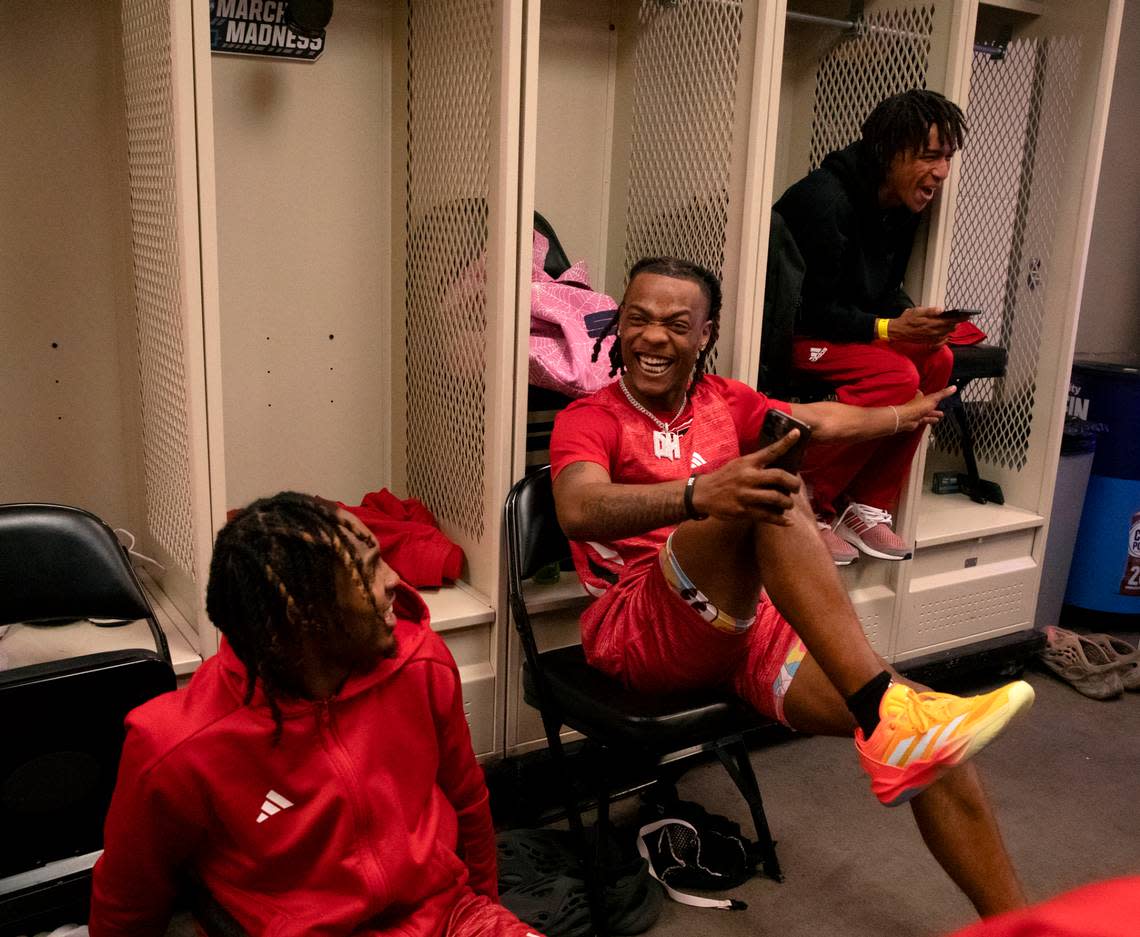In this era of college hoops — of 5th years and transfer portal — everyone knows everyone

The locker rooms for N.C. State and Oakland happen to be next to each other inside PPG Paints Arena, and while their practices did not overlap Wednesday, they were adjacent enough for Wolfpack forward Mohamed Diarra to find Grizzlies assistant coach Bobby Naubert in the hallway, Diarra on his way in, Naubert on his way out.
The two posed for a photo in front of the big March Madness backdrop CBS had erected in the corridor. Two years ago, Diarra was in his second season at Garden City Community College in Kansas. Naubert was in his first as an assistant coach there. Wednesday, their paths crossed again.
“He was a good coach,” Diarra said. “He helped me a lot. Gave me a lot.”
This subregional is awash in these kinds of connections, some of the more traditional kind — John Calipari returns to his hometown, sending the Pittsburgh TV stations into a minor frenzy — but many more are a product of college basketball’s modern era, of extra COVID years and NIL-fueled decisions to stay in school instead of playing pro overseas and the transfer portal — essentially, the way things are now.
Players change teams more often and stay in college longer. Throw those two very-2024 developments together, and you’re left with a tangled web of friendships, acquaintances and rivalries that runs deeply through the game, coast to coast and top to bottom.
“Going in as a freshman, I didn’t really know that many people besides guys I grew up playing with. I didn’t have that many connections,” said N.C. State guard Michael O’Connell, who transferred from Stanford and played many games against Oregon, in the other pod here in Pittsburgh.
“But as I started to meet more and more people, and then you meet their friends on other teams, and then obviously guys transfer out and you see them at different schools and meet their teammates. It’s definitely been pretty crazy crossing paths with these guys whether I’m playing them or seeing them on TV in a different uniform. It’s pretty cool to watch everyone’s different journey, different paths.”
It’s not quite that everyone knows everyone, but throw eight random teams together in one place for the first weekend of the NCAA tournament, and you’ll find a lot of people here in Pittsburgh know a lot of other people here in Pittsburgh, where 11th-seeded N.C. State faces sixth-seeded Texas Tech in the late game Thursday night.
N.C. State assistant coach Joel Justus spent seven seasons on Calipari’s staff. Kentucky freshman Rob Dillingham was once committed to N.C. State; a potential second-round meeting awaits. Same for N.C. State’s D.J. Horne, who played with Kentucky’s Antonio Reeves at Illinois State and will see two former Arizona State teammates in the first round: Texas Tech’s Devan Cambridge and Warren Washington.
Oregon guard Jermaine Couisnard spent three seasons at South Carolina before transferring to the Ducks; in his fifth season, he’ll play in his first NCAA tournament game … against his former school. Meanwhile, N.C. State’s Jayden Taylor played with Akron’s Ali Ali last year at Butler, before they both went elsewhere this season.
“He actually called me last night to find out what hotel I was at,” Taylor said. “We were like 25 minutes apart, so we didn’t link up. But I’m going to root for my guys until they play us. I’m going to root for him.”
Then there’s Kerwin Walton, who started his career at North Carolina and thought he was done with the Wolfpack, but he’ll play one more game against them for Texas Tech.
“I remember playing these guys a few times the first couple years at Carolina,” Walton said. “It’s always been animosity between the two schools. But it’s a whole new environment for me so it’s going to be a little different game, different feeling.”
Those rivalries are never far from the surface. Of all the congratulatory texts Horne got, his favorite came from Bobby Hurley, his former coach but famous around these parts for other reasons: “Thanks for beating those Tar Holes.”
Start looking deeper, and some of it’s enough to make your head spin.
At Illinois State, Horne played with Dusan Mahorcic. Then the two played against each other in the Pac-12, Horne at Arizona State and Mahorcic at Utah, before Mahoric transferred to N.C. State, where he was on the roster but injured when the Wolfpack played Creighton in the first round in Denver last year, where Arizona State played as well. And now Horne is playing for N.C. State and Creighton is again in the other pod at the same site, while Mahorcic is in the NCAA tournament with Duquesne, whose campus is a few blocks from PPG Arena. (Duquesne is playing in Omaha, where, if you really wanted to take this too far, Creighton is located.)
Exhale. You need to draw a map to keep up with this stuff.
And to a degree, it’s always been like this. Coaching trees and AAU teams always have roots that run deep and cross over in the basketball topsoil, twisting and tangling. But thanks to the transfer portal and prolonged careers, there has never been cross-pollination like this in college basketball itself, across the entire landscape of the game.
“It is crazy,” Horne said, “how this whole basketball thing works.”
Never miss a Luke DeCock column. Sign up at tinyurl.com/lukeslatest to have them delivered directly to your email inbox as soon as they post.
Luke DeCock’s Latest: Never miss a column on the Canes, ACC or other Triangle sports


